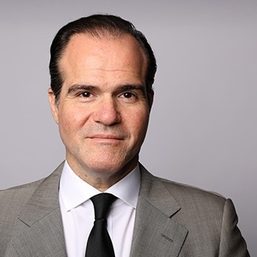SUMMARY
This is AI generated summarization, which may have errors. For context, always refer to the full article.
 When one gets more and more but it’s more and more of the same, the returns of excitement gradually diminish.
When one gets more and more but it’s more and more of the same, the returns of excitement gradually diminish.
What they say about having too much of good things is a warning often unheeded.
Consequently, what they also say about getting what one wants but not what one needs comes too late a realization.
Although devastated by successive calamities in the country’s central islands in the last year, a looming energy crisis, electricity supply shortfall, and rising geopolitical tensions in the South China Sea while minimum credible defense position remains unrealized, the Philippines did not have a deficit of good things coming along the way in the past couple of years.
For a long time “the sick man of Asia,” the Philippines is now hailed by many a foreign publication and credit ratings agency as Asia’s most promising economy, including the world’s sweetest tourist destination.
Some government targets have been hit. Some have been missed.
In a way, the State of the Nation today is akin to a bachelor on his typical night prowl. Some nights he ends up with a target. Some other nights he goes home drunk, alone, and hurting on his ego.
But he likes to maintain it that way. At least, it works, he says.
And as it appears, so is the Philippine nation and its bachelor head of state and government, President Benigno Aquino III.
One can say that Akbayan Representative Walden Belo’s description of the Philippines as a state of permanent crisis has now been replaced by a state of permanent bachelorhood.
Stats of the nation
Rosy statistical data have under the Aquino administration (and in no less a manner than it had been under the preceding Gloria Arroyo administration) become trophies of much vaunted performance success.
It is pointless to argue against the benefits of attaining growth targets. But why those growth targets have to be achieved is a question that always invites speculation. More importantly, how growth could actually translate to concrete gains for poverty reduction remains for the most part, shady. Not to mention, the selection of which statistical data to present or to believe in is often impregnated by academic and/or ideological baggage.
Some analysts are drawn to budget surpluses, soaring remittances from overseas Filipino workers (OFW) buoying the services, consumption, and property sectors, and continued influx of hot money. Some pay attention to mediocre infrastructure spending, snail-paced Public-Private Partnerships (PPPs), lack of diversification in the production base, and dismal Foreign Direct Investment (FDI) inflows. It is unsurprising that conversations on growth along these parameters often end in impasse.
The thing is, statistics is a poor substitute for vision.
Narrative lost, narrative not regained
That vision used to be “anti-corruption.” And despite public skepticism over some key appointees in the Aquino Cabinet, the narrative held ground for some good 3 years. It lost steam when Aquino was exposed to have been selectively prosecuting corrupt officials of the opposition. While there are a good number of individuals still willing to give Aquino the now-fashionable “presumption of regularity,” one can only play on broken strings a limited number of tunes.
But even when a large majority of the population was still taken by the narrative, its discourse was already weak, and contrary to the proclamations of government officials, the alternative mechanisms pursued were not really that innovative.
Take the case of the supposed innovations under the Disbursement Acceleration Program (DAP). Budget Secretary Florencio Abad insists on the scheme’s novelty. But recent statements purporting that it has been practiced by past administration but has only been questioned now reveals a glaring contradiction. When pressed to defend it, Abad and Aquino officials fatally exposed its largely uninspired and recycled origins.
The government remains stubborn and in more recent weeks desperately tried to stem the erosion of public trust and confidence. Weeks before his 5th State of the Nation Address, Aquino’s trust rating dropped to its lowest level since he assumed power. Unless Aquino reclaims the “anti-corruption” narrative or reinvents it to gather popular support, the reformist gains of his administration attained through selectively prosecuting political enemies run the risk of being dismantled by a potentially politically vindictive successor administration.
Let it go

But that coupling of success in weeding out corruption with the continued leadership of the ruling political coalition indicates precisely that even the administration is unsure if its initiatives could be sustained in case its anointed saints of reform fail in their 2016 election bids.
Sure, no one will challenge the wisdom in weeding out, jailing, and campaigning against government officials engaged in corrupt practices. But a visionary leader is less interested in continuing or protecting a legacy than in passing on the reins of power to the indeterminate energy of a future generation of leaders.
Committed leaders see the big picture and pursue ends toward the big picture. In the absence of a vision, leaders turn to seeking control. It is surprising that Aquino who has dated a handful of women while in office could not easily let go of a set of people who has his ear. And a set of malignant conditions too that have long plagued democracy in the Philippines.
Tactical but not strategic
Government insiders and Aquino apologists argue that sweeping changes in the political landscape are tactically lethal to the administration’s survival.
This is perhaps why under Aquino, proposals to legislate an Anti-Political Dynasty Law, a Political Party Reform Law, a Freedom of Information Law, as well as amendments to the 1987 Constitution’s restrictive economic provisions have all but received the President’s strong political will in support. These measures may not necessarily be tactically good moves. But they are strategic to securing the sustainability of reform initiatives.
Tactical victories such as removing spending bottlenecks which the DAP has purportedly achieved undoubtedly generated quick returns to Aquino’s political capital, enough for majority of his allies to win during the 2013 midterm elections. When interrogated, however, whether DAP-related spending followed transparent processes and boosted productivity, Aquino’s budget officials were quick to wash their hands, passing the buck instead to the oversight function of the Commission on Audit. Again, in the absence of a strategic vision and in pursuit of quick returns, the Aquino administration’s justifications fail to persuade.
Liberal lethargy
In the last 3 years under President Aquino, the Philippine nation got a lot of things it wanted: a partial (and rather short-lived) restoration of the government’s credibility, global recognition, and a fairly stable economic order.
But restored trust and confidence that a damaged system could still be made to work has stunted policy ingenuity and audacity. It instead entrenched the vested interests of the limited few who stand to benefit from the system’s continuity.
Global recognition too has kept the public distracted. Meanwhile, the stability of the economic order driven largely by a very limited growth sector has redefined workers aspirations from productivity generation toward mere wealth and income accumulation. Without government efforts to diversify sources of opportunity, inequality not just in income but also in culture as well as social consciousness has continued to rise.
The next couple of years should now compel President Aquino and his government to give the Philippine nation what it truly needs, even if it’s not what he and his allies want. – Rappler.com
Add a comment
How does this make you feel?


![[WATCH] Try This: Empanada Salteña from Argentina](https://www.rappler.com/tachyon/2023/04/try-this-empanada-saltena-argentina.jpg?resize=257%2C257&crop=765px%2C0px%2C1037px%2C1037px)


There are no comments yet. Add your comment to start the conversation.